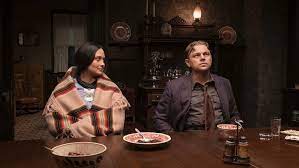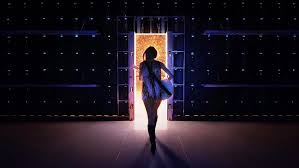Killers of the Flower Moon 2023 Movie Review
Taking a cue from the movie’s soon-to-be-infamous spanking scene between Robert De Niro and Leonardo DiCaprio, someone ought to paddle whoever let Martin Scorsese take three and a half hours to retell “Killers of the Flower Moon.” You could read David Grann’s page-turner — about an audacious 1920s conspiracy to steal resources from the Osage people by murder — in less time, and you’d learn a whole lot more about how J. Edgar Hoover and the newly formed FBI used this case to establish their place in American law enforcement.
Granted, this is cinema legend Martin Scorsese we’re talking about. For years, he fought studio execs telling him what to cut, going head-to-head with Harvey Weinstein on “Gangs of New York” (a movie that probably would’ve been better longer). Now he’s earned the right to tell stories as he sees fit. Trouble is, at 206 minutes (still four shorter than “The Irishman”), “Killers of the Flower Moon” isn’t an epic motion picture so much as a miniseries. Nothing wrong with that, except it’s intended for the big screen — where Apple has committed to release it this fall. Closer to two hours, “Killers” would make a killing, whereas longer than “The Longest Day,” most folks will wait to watch at home.
This is why someone needs to stand up and tell Marty to rein it in. They should’ve done it before he started shooting, since the pace is built in, and Scorsese’s projects don’t compress well after the fact. In its present form, “Killers” is still a compelling true story, one that Scorsese and co-writer Eric Roth shifted from being a standard white-savior detective yarn to a more morally thorny look at how the white culprits plotted and carried out the murders. Stylistically, this feels like a young man’s movie. It’s engrossing from the get-go, the palpable tension methodically echoed by Robbie Robertson’s steady-heartbeat score. But it keeps going and going until everyone we care about is dead, dying or behind bars, with nearly an hour still in store.
Years earlier, the tribe had been forced by the U.S. government to relinquish its ancestral homelands and relocate to undesirable Oklahoma land, where it got rich virtually overnight when oil was discovered beneath its feet. An early scene of that first gusher being discovered recalls “There Will Be Blood,” much as the De Niro-DiCaprio paddling does that film’s bowling-alley finale — although I’m afraid “Heaven’s Gate” is the more fitting comparison: a morally indignant look back at a slow-motion massacre that gets so bogged down in details, it loses the thread.
Scorsese opens on prosperous times for the Osage people, who’d become the wealthiest Americans per capita, thanks to the countless oil derricks that cover their bland land. That made them obvious targets to be exploited. Early on, the director draws a direct line between the Osage Murders and the 1921 Tulsa Race Massacre, referenced via old-timey newsreels — both cases in which white supremacists couldn’t stand to see others prosper, counting on a biased legal system to cover their crimes.
But this isn’t the story of one murder. Taking a page from “Goodfellas,” Scorsese runs through half a dozen suspicious deaths right upfront, dismissed without investigation, including a “suicide” where we see someone shoot an Osage woman through the chest, then restage the scene by placing the gun near her hand. That’s the climate into which DiCaprio’s character, an opportunistic World War I veteran named Ernest Burkhart, moves to Fairfax, Okla., where he soon finds himself participating in the killings. Ernest’s first stop off the train is his uncle William “King” Hale’s place, where the well-connected cattleman (played by De Niro) welcomes him to town, glad to have the perfect patsy.
Ernest doesn’t realize it, but the scheme is already underway. For it to work, King needs his nephew to marry Mollie Kyle (Lily Gladstone), an Osage woman who’s too sharp not to recognize a gold digger, but too trusting to imagine just how sinister her suitor’s intentions may be. Almost right away, her relatives start dying of suspicious causes. One sister succumbs to a strange “wasting disease,” another is discovered with a bullet wound to the back of her head, and the third dies in an explosion so big, it blows out all the windows for a mile in every direction.
No question, these crimes are unconscionable. To make audiences feel the revulsion, Scorsese shoves the victims’ bloody skulls in our faces — except he knows full well that audiences crave “whackings.” In a way that seems almost strategic, given the running time, the murders perversely become a thing to look forward to, carrying viewers through long dry stretches of drama till the next horrific execution. With each death, the family fortunes flow toward Mollie, whose headrights can legally pass to her husband, if she so bequeaths it — all as King had foreseen.
Reducing most of the Osage to glorified extras, it’s classic Scorsese to present this case from the criminals’ perspective, much as “Casino” tracked Vegas’ roots as a gangsters’ paradise. The filmmaker has always shown a fascination for corruption, violence and underground dealings, and Grann’s book offers all that, plus an intriguing challenge for producer DiCaprio, who plasters a gargoyle-worthy frown across his mug for most of the film. Meanwhile, Gladstone is so sympathetic as Mollie, we cringe as Ernest slowly poisons her with tainted insulin. DiCaprio has never gone this far to the dark side, daring us to follow along as Ernest bumbles his way through a stone-cold “Gaslight”-style plot to steal his wife’s fortune.
The country’s ambivalence toward Natives makes their job easy, and without getting bogged down in context, “Killers” illustrates some of the ways the system was designed to defraud them — such as certifying a number of Osage “incompetent,” such that white men would be assigned to administer their trust funds. Others charge the Natives outrageous prices, or take insurance policies on their debts, the way King does Henry Roan (William Belleau) before bumping him off.
Politically well connected, King had the authorities in his pocket and the nerve to conduct a fair amount of his scheming out in the open. Instead of telegraphing his duplicity, De Niro lays on the charm, serving as a kind of godfather figure to everyone in Fairfax — though King’s actions suggest that every line might be uttered with fingers crossed behind his back.
The obvious way to tell this story — the one Grann took for his book — would be as a criminal investigation. But the movie makes a stronger impression asking audiences to identify with the killers, while showing how this conspiracy impacted the Osage Nation. On a couple occasions, Scorsese takes us inside tribal council meetings, where Native spokesmen complain that no one cares about the murders in their midst. If they want the deaths investigated, they’ll have to pay for it themselves. When they finally send a representative to Washington, D.C., to address the Indian Affairs office, that man winds up bludgeoned to death in a ditch. And when Hoover dispatches a former Texas Ranger, Tom White (Jesse Plemons), Ernest and King hardly give him the time of day.
White eventually cracked the case, much to the FBI’s glory, though that part of the film nearly grinds to a halt as Mollie teeters on death’s precipice — as indicated by visions of the owl her mother identified as an omen before her own passing. In a chilling scene, this once-proud, stoic-even-in-outrage woman looks her husband in his paunchy, pathetic face and demands to know what he gave her. Scorsese constructs the movie’s drawn-out climax around Ernest’s choice: Will he protect King to the bitter end, or will he testify against his uncle and maybe save Mollie in the process? The decision comes down to the fate of his children, who somehow got short shrift in the preceding three hours.
So how does Scorsese justify the running time? Shooting the film on location in Oklahoma, he and DP Rodrigo Prieto immerse audiences in the oil-rich community, featuring street races and downtown parades, plus a stunning scene in which King’s fields burn, like the hellish inferno in “Days of Heaven.” Picnics and powwows provide more than just production value, situating this incredible story within a singular place and time.
“Can you find the wolves in this picture?” a vintage Osage history book asks, encapsulating the challenge Scorsese sets for his audience. Instead of following the courtroom drama to its natural conclusion, longtime editor Thelma Schoonmaker cuts to a Technicolor epilogue, as a Hoover-endorsed radio show summarizes what happened. It’s a brusque way to wrap a film that’s taken its time thus far, and a reminder that no one is telling Scorsese no — because if this device were an option, it could have kicked in an hour earlier.




